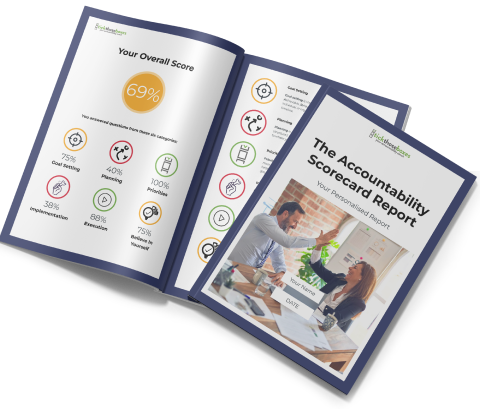
Accountability for Business Owners
Learn how accountability can help business owners build more sustainable
The Accountability Guy®

In our past discussions, we have mentioned critical components of accountability. Those components are clarity, coaching and feedback. The features can ease settling in and create a good workplace environment. We all know about the benefits of accountability that organizations can reap. So, let us have looked at the benefits of accountability –
We know the advantages the organization will gain, but now we must understand how to build an accountable work culture. Well, it’s easier said than done. But it requires some trial-and-error methods, consistency, patience and a shift of mindset. So, let’s look at the tips of building an accountable culture in workplace.

Discover your Accountability Score and increase the probability of smashing your GOALS and Getting Sh!t Done!
1. When we talk about setting proper expectations, it is equally important that they understand how each of their performances impacts the organization’s overall performance. Why? The answer is straightforward. One must realize that an organization’s overall performance depends on the entire team’s performance. If one person fails to present desired results, it impacts the general company’s profit.
2. When I talk about goal setting or goal-oriented, it includes that we include employees too in goal setting. As they should be aware of what they are working on. It is vital that they can contribute towards the goals, and they can contribute towards the risks and factors that might impact achieving those goals. That’s where the leader can help them assess their challenges and work with them to overcome them.
3. Setting clear expectations from day one has been the critical point we have discussed numerous times. When an employee comes on board, the organizations should set clear expectations of what they are expecting out of that employee and the job role and what the employees can expect out of the organization. When you make it clear from day one the employees would learn to work around the expectations from the start.
4. A helpful way to encourage them to improve their performances is to explain to them that they do not have to fear the failures they might face. From the beginning, they will only be able to achieve some of the targets set for them. So, it’s ok if they fail in some goals. That they will gain some sense of stability and safety at work. That will give them the chance to improve and perform better.
5. When the leadership forms goals for their staff members, they must provide all the required resources to ensure they can achieve the goals. For example, if the salesperson joins the team, the director must give him the list of clients that he is supposed to cater to, and gives him transport to make sure he can travel easily. The leadership should be able to provide proper training to their team members to teach them suitable methods effectively.
6. In the last posts, we have discussed time and time again about the feedback culture. And feedback is one of the three components that can help ease the process of adapting accountability at work. Feedback works when it’s two ways. Not only when the leadership gives feedback to the employees but also when the team members provide input for their leaders. Feedback is more effective when it is accepted positively and then worked on to make necessary changes.
7. Continuous coaching is an essential aspect when we talk about bringing Mindshift towards accountability. When we preach about accountability at regular intervals, the employees can associate with it even more and become more adaptable to changes.
8. Bringing transparency to the workplace can generate good relationships and better results. When you allow the employees and leadership to create a more transparent climate at work, they will be able to build trust, great teamwork and respect for each other.
9. Whenever the team members can perform to their expectations and deliver desired or even better results, the leadership must encourage and motivates the employees and often celebrates the wins whenever they can.
10. It is equally crucial for the leadership team to measure the progress. Whether it be by morning meetings or weekly meetings where they have the opportunity to sit with the team members and talk about their progress and challenges that they are facing towards the goals.
When we talk about accountability, it is clear that we depend on the fact that it is executed at all levels. Employees who are setting good examples must be promoted across the board. Accountability also improves employee engagement and performance. Once you have a team of committed and competent employees, then adapting to accountability is about enabling the employees to generate the desired results. Accountability is another step ahead to leading your team into the mode of success and proactive behaviour. Well, it is closely related to responsibility but also about promoting healthy relationships at work.

Darren Finkelstein, The Accountability Guy®, is the founder of TICK THOSE BOXES, a specialised accountability coaching practice. Darren is a formidable international accountability coach, business advisor, mentor, and author/speaker, fostering development and measurable results in entrepreneurship, leadership, and accountability. Darren’s tale is one of perseverance, self-reinvention, and resilience.
With compelling execution, Darren has empowered high-achieving individuals and teams from Australia and New Zealand to Latin America, Europe, Asia, the UK, and the US to embrace accountability; after all, it is your superpower.
Darren’s one-on-one and group coaching programs are based on his bestselling business book, “The Accountability Advantage – Play your best game” and the latest, release “NO’ – Building a life of choice without obligation”.
Darren has an impressive background in business, having held the role of “Manager of Commercial Markets” at Apple Australia during the Steve Jobs revolution.
He enthusiastically “walks the talk,” having also successfully sold and exited his lifestyle businesses, which served as the impetus for establishing his coaching and mentoring business.
Join Darren on this transformative quest to accomplish the remarkable.
Read Darren’s full bio here:
https://tickthoseboxes.com.au/about/

Know what to do first

know what to do next

know what to do more of

Learn how accountability can help business owners build more sustainable

Boost productivity and trust within your team. Unveil the power

Learn about Positive Accountability, see what it is, why you

Accountability drives success in so many ways. Whenever I coach

Are You Responsible or Accountable? The underlying principles undoubtedly apply

Discover why accountability is crucial for effective leadership. Learn how
Navigation
Learn More
Contact
Social Media
Copyright Darren Finkelstein 2022 | Privacy Policy | Terms and Conditions